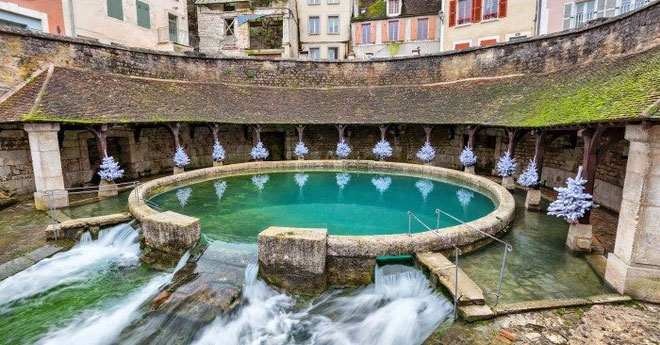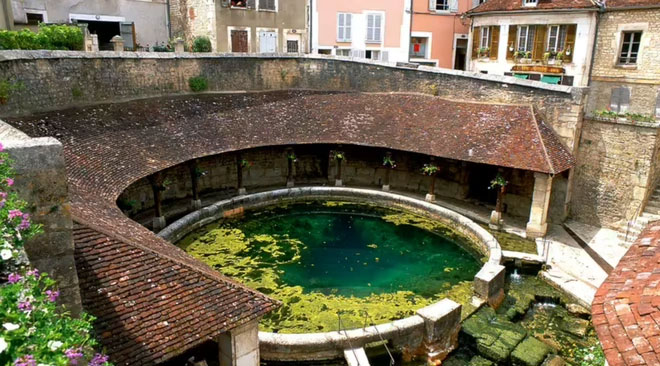Mysterious underground springs have not been solved in France
In the quaint town of Tonnerre in northeastern France, there is a deep spring known as the Fosse Dionne. So far, despite trying hard to find the answer, no one has been able to determine its origin.
There may be a giant, deadly snake lying at the bottom of the Fosse Dionne stream in the Burgundy region of France. It is a legend created by the ancient inhabitants of the village of Tonnerre where the spring is located. However, in reality, no one has yet reached the end of this mysterious spring.

The Fosse Dionne is a circular stone swimming pool built in the 18th century.
Fosse Dionne is a karst spring (karst is an irregular limestone region with sinkholes, underground springs and caves), which spews an average of 311 liters of water per second. This is an unusually high discharge, but the velocity at which the water shoots out of the ground varies with the seasons.
The Fosse Dionne, meaning "holy pit", is an eighteenth-century circular stone swimming pool filled with turquoise, amber and sequoia colored water, colored by minerals in the pools. limestone cave.
Locals used Fosse Dionne's water for drinking, washing, cooking and bathing. In the Middle Ages, it was thought that there was a snake circling deep in the heart of Fosse Dionne, and some have even suggested that it was a portal to another world.
Today, the Fosse Dionne is re-planned with a stone basin surrounded by a reservoir, a communal laundry, built in the 18th century to protect women from danger. But below the surface of the water, the visible image remains intact with the passage of time.

No one has yet reached the end of this mysterious spring.
Fosse Dionne's biggest mystery is where its water actually comes from. There's certainly a lot of water coming out of it, and like other limestone springs, the water emerges from a network of underground limestone caves. However, not a single diver was able to trace its origin, and many of them perished.
No one dared attempt to delve into the depths of Fosse Dionne until 1974, when two divers began mapping the mysterious spring. But neither of those divers returned to tell what they had seen.
In 1996, another diver tried to make the discovery, but also lost his life. For many years after that, divers were banned from diving in the spring, until 2019, when diver Pierre-Éric Deseigne explored the 370-meter passageways.
It is thought that the Fosse Dionne was supplied by both rainwater from the hills around Tonnerre and at least one underground river.
Like other limestone springs, the water emerges from a network of underground limestone caves, but no one has been able to pinpoint its exact source. The divers perished on the search for answers brought to a halt the mystery surrounding the stream. Therefore, the secret of the Fosse Dionne stream has so far remained unsolved.
- The 4,000-year mysterious village lies underground in China
- Caves with mysterious drawings in France
- Audi introduces lightweight lightweight composite material
- Mysterious earthquakes all over the world have found a solution
- The story strayed into the underground world of the 5-year-old boy, confusing the scientists
- Hanoi: Mysterious underground cave under ancient communal house near West Lake
- The mysterious telegram could not be solved from World War II
- Mysterious stone statues of prehistoric stone in France
- Video: Slinky spiral springs run extremely impressively
- Discover mysterious underground structures in Russia
- Reveal another world 4.5 billion years old that was swallowed up by the Earth
- Successful fabrication of 'nano-springs' helps break down marine plastic
 The truth about the mysterious red-haired giant at Lovelock Cave
The truth about the mysterious red-haired giant at Lovelock Cave Inunaki Tunnel: The haunted road leading into Japan's 'village of death'
Inunaki Tunnel: The haunted road leading into Japan's 'village of death' The mystery of the phenomenon of human reflection before dying
The mystery of the phenomenon of human reflection before dying 6 mysterious phenomena, although science has been developed for a long time, still cannot be answered
6 mysterious phenomena, although science has been developed for a long time, still cannot be answered